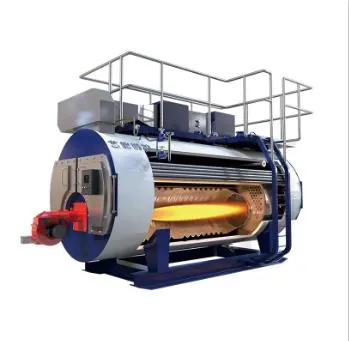Steam Boiler: The Source Of Industrial Power
Stoomketel, A device that uses fuel combustion to heat water and convert it into steam, playing a crucial role in modern industrial systems. From power plants to chemical enterprises, from textile factories to food processing plants, the heat provided by Steam Boiler drives countless production processes and is a powerful driving force for industrial development. Despite the continuous emergence of new energy utilization methods with the advancement of technology, Steam Boiler still holds an important position in the energy field due to its mature technology and wide range of application areas.

There are many types of Steam Boiler, which can be classified into different types according to different classification criteria
According to the circulation mode of boiler water, it can be divided into natural circulation boilers and forced circulation boilers; According to the type of fuel, it can be divided into coal-fired boilers, oil fired boilers, gas boilers, etc; According to the structural form, it can be divided into water tube boilers, fire tube boilers, etc. Different types of a steam boiler have their own characteristics and applicable scenarios, and need to be selected according to specific industrial needs. For example, large power plants typically use water tube boilers because they can withstand higher pressures and temperatures, thereby improving power generation efficiency.
The working principle of Steam Boiler is relatively simple, but it involves multiple complex physical and chemical processes
Firstly, the fuel burns inside the combustion chamber, releasing a large amount of heat energy. These heat energies are transferred to the water inside the boiler, causing the temperature of the horizontal steam boiler to rise and eventually vaporize, producing high-pressure steam. The steam is further heated by the superheater to increase its enthalpy, thereby improving the availability of steam. Subsequently, high-pressure steam is transported through pipelines to various steam consuming equipment, driving turbines, heating devices, etc., to complete energy conversion and utilization. The smoke generated by combustion is treated with dust removal, desulfurization, and other methods before being discharged into the atmosphere.
Steam Boiler also faces some challenges
Traditional coal-fired boilers generate a large amount of pollutants such as sulfur dioxide, nitrogen oxides, and particulate matter, causing serious environmental pollution. In addition, the noise and thermal radiation generated during boiler operation can also affect the health of workers. Therefore, improving the combustion efficiency of boilers and reducing pollutant emissions have become important directions for the development of heating steam boiler technology.
With the increasing awareness of environmental protection and continuous technological progress, the application of Steam Boiler is becoming more and more widespread---h2
New industrial steam boilers such as gas boilers and biomass boilers are gradually receiving attention. These boilers use clean energy as fuel, significantly reducing pollutant emissions. Meanwhile, by adopting advanced combustion technology and flue gas treatment technology, the environmental performance of the boiler has been further improved. In addition, the application of waste heat recovery technology has effectively improved the energy utilization efficiency of boilers and reduced operating costs.
In summary, Steam Boiler, as a mature and widely used thermal energy device, plays an irreplaceable role in the development of modern industry. Faced with increasingly severe energy and environmental challenges, Steam Boiler technology is constantly innovating and developing towards cleanliness, efficiency, and intelligence, in order to better meet the needs of industrial development and contribute to building a sustainable society.
Steam Boiler FAQs
What is the basic working principle of Steam Boiler?
Steam Boiler heats water to its boiling point by burning fuels such as natural gas, coal, biomass, or electric heating to produce steam. Steam is transported through pipelines to heat consuming equipment such as heat exchangers, turbines, drying systems, etc., where it releases heat and condenses into water, which can be returned to the boiler for recycling (closed system) or discharged (open system).
What are the main types of Steam Boiler?
Classified by structure and work pressure:
Fire tube boiler: The flue gas flows inside the pipeline, while the water flows outside (suitable for low-pressure small capacity boilers such as Lancashire boilers).
Water tube boiler: Water flows inside the pipeline, and flue gas flows outside (suitable for high pressure and large capacity, such as power plant boilers).
Electric Steam Boiler: No combustion, direct electric heating (environmentally friendly, suitable for laboratories or small industries).
Vacuum boiler: operates under negative pressure and has high safety (commonly used for civilian heating).
What are the key safety devices of Steam Boiler?
Safety valve: Automatically releases steam when overpressure occurs.
Water level controller: prevents dry burning (low water level alarm) or full water (high water level cut-off).
Pressure gauge/pressure sensor: Real time monitoring of steam pressure.
Drain valve: Regularly remove impurities from the boiler water to prevent scaling and corrosion.
Flame monitoring system (gas boiler): automatically cuts off fuel supply when turned off.
Why is Steam Boiler processing important? How to handle it?
Importance: Hard water can cause scaling (reducing thermal efficiency), corrosion (damaging pipelines), and steam water co distillation (steam carrying water).
Handling method:
Softened water: Use ion exchange resin to remove calcium and magnesium ions.
Add chemical agents such as oxygen scavengers and corrosion inhibitors.
Regular discharge: Control the salt content in the boiler water.
How to improve the energy efficiency of Steam Boiler?
Waste heat recovery: Install economizer (preheating feedwater) or condenser (recovering latent heat of flue gas).
Insulation optimization: reduce heat dissipation losses of pipelines and boiler bodies.
Regular maintenance: clean the heat exchange surface, remove scale, and check the efficiency of the burner.
Automatic control system: Adjust the ratio of fuel and air flow according to the load (such as oxygen feedback control).
-
Hebei Yineng Boiler will attend Shoes & Leather Exhibition- Vietnam 2025NuusJul.01,2025
-
Understanding Waste Heat Boilers: Revolutionizing Energy EfficiencyNuusJun.24,2025
-
Industrial Hot Water Boiler: The Backbone of Efficiency and ReliabilityNuusJun.24,2025
-
Industrial Hot Oil Heater: The Ultimate Solution for Your Thermal NeedsNuusJun.24,2025
-
Horizontal Steam Boiler: The Optimal Solution for Industrial ApplicationsNuusJun.24,2025
-
Electric Steam Boiler for Industrial UseNuusJun.24,2025

